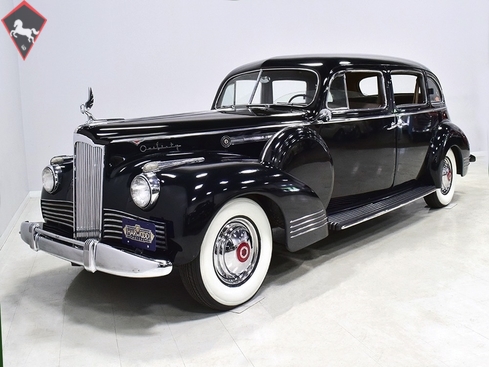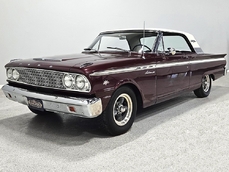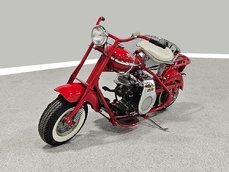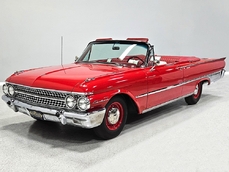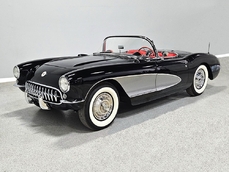Packard 160 356 cubic inch straight-8 1942
General description :
Original cars, also called “survivors,” are an interesting case study of the evolution of the old car hobby. For many years, nice original cars would routinely receive restorations, ostensibly starting with the best base stock made the job easier and less expensive. More recently, however, enthusiasts have started to appreciate the finer details and look beyond shiny paint to realize that preservation of a quality original car also preserves history and provides a reference for future restorers who are forced to work with less than stellar examples. And like many inflection points in the hobby, some folks get it and some wonder why someone would want to own an old car with a dirty chassis and chips in its paint. That’s OK, and it’s why the hobby offers such a stunning variety of cars of all types, in all kinds of condition, and at all price points.
If you are of the opinion that old cars should be restored to perfection, then I’ll let you know up front that this 1942 Packard 160 Super 8 6-passenger sedan is probably not for you. On the other hand, if you appreciate cars that have been lovingly maintained for decades and still boast the quality installed in them by their makers, then this Packard is a special car. It has a known history, starting with a funeral home in Cleveland, Ohio, which special-ordered it with a variety of unique features (which we’ll get to in a moment). In 1952, it was purchased from the funeral home by a long-time member of the Ohio Region of the Classic Car Club of America, and remained in the family’s collection until his son’s death in 1994. It remained in storage for a few years as the widow couldn’t bear to part with it, but it eventually ended up in the collection of the CCCA’s head judge, who had an especially strong interest in unrestored, original cars like this. It was toured and used for various events, including the Packard Meet in Switzerland in 2015, and it was toured extensively through Europe at that time. It is now available, with the fourth owner’s name yet to be written.
The car remains in almost entirely original condition and shows just over 38,000 original miles (it has an original mileage title and club records indicate that it had 33,000 miles in the early 1990s). It’s an unusual car for a variety of reasons: it’s a 1942 Packard, with some estimates putting production in the hundreds. Two, it is a Packard 160 on the 138-inch chassis, which was usually reserved for the 180. Three, it is equipped with a divider window like a formal sedan, but does not have the formal sedan’s padded roof. Four, there’s a single jump seat in back, sometimes referred to as an “assistant’s seat,” making it a six-passenger model. Finally, there are snaps on top of the front seat back, suggesting either a factory seat cover, or—more likely—a snap-on privacy curtain for the divider window, which makes sense given its funeral home origin.
The glossy black lacquer paint shows why Packards were special, and even after nearly 80 years it shines up beautifully. Yes, of course there are signs of age, including some minor checking and some chips in the finish, most notably on the sidemount covers, but nothing that requires attention or detracts from the presentation. Original paint is special for a variety of reasons, not the least of which is the fact that there is no bad news hiding underneath—original paint means original steel and no botched bodywork for a new owner to manage. The quality of the finish is testament to the car’s care, which was surely impeccable while in funeral home service, and thereafter it was treated as a special car, used only on weekends during nice weather. This car has been loved and it shows. It looks a bit nicer in photos than it does in person, simply because the camera can’t capture the minor crazing and micro-blisters, but even in person is presents beautifully. Again, people who understand survivors will find it lovely while those who insist on shiny perfection will wonder about the cost of a paint job. It is my personal and professional opinion that painting this car would be a crime.
It’s worth mentioning that the front and rear bumpers were re-chromed in the ‘80s and a friend familiar with the car says that the “One Sixty” script emblems on either side of the hood were installed at that time (he knows this because his father supplied the emblems). It’s likely that the funeral home ordered the car without emblems, but they are correctly installed today. The remaining chrome and stainless trim is in excellent original condition, including the tall Packard grille which features fully operational thermostatically-controlled shutters. There is very, very minor pitting on some of the cast details such as the hood ornament, vent window frames, and fender lights, but again, nothing that will require restoration or refinishing.
The tan wool broadcloth interior is likewise beautifully preserved and entirely original. With so few miles, it should not be surprising that there is very little wear on even the driver’s seat, which shows only minor scuffing on the trim bead where someone would slide behind the wheel. The simple patterns were part of Packard’s understated elegance, working with the woodgrained garnish moldings and dashboard, all of which are in excellent condition. Factory gauges are all functional and in 1942, Packard eliminated the manual choke and throttle knobs, greatly simplifying the dashboard. The original steering wheel is in good shape, save for some cracking around the chrome rings on the horizontal spoke. As a funeral vehicle, there was no need for a radio, so it sports a factory block-off plate, and even though the instrument panel has an indicator for overdrive, this car is not equipped with an overdrive unit (what need for it in a funeral procession?). The original electric clock ticks away reliably and at some point an auxiliary 6v power outlet was installed under the dash. There is also a discreet toggle switch for the electric fuel pump and a dealer-installed switch for the defroster, which works properly. The rear seat is just as beautifully preserved, with excellent upholstery and a folding jump seat that looks almost completely unused and even the carpets appear to be original equipment. The divider window crank (which is sadly missing its knob) is hidden behind the panel with a working wind-up clock, and a storage compartment takes the place of the passenger’s side jump seat. That’s a heater unit in the center, but we have not tested it. The trunk is plain and functional, but includes a matching full-sized spare so you don’t have to wrestle with the sidemounts if you’re in need.
There are some who will argue that the final 356 cubic inch straight-8 is the best of Packard's best, and I can't disagree. In 1942 it was rated at 160 horsepower, but it isn't horsepower that makes this engine sing, since it doesn't really like to rev, but rather the effortless creamy-smooth torque that moves this car like it's powered by an electric motor. The engine has never been apart and runs beautifully, starting with the original accelerator pedal switch and cruising easily at 60 MPH. Routine maintenance items have been recently serviced, including a full tune up, and there's evidence that the radiator has been re-cored and the water pump replaced, making it mechanically healthy. There’s been some touch-up of the Packard Green engine enamel, but it appears that most of the finishes are otherwise original. There are no notable deviations from stock beyond hose clamps and maybe a few nuts and bolts, easy enough to rectify if absolute authenticity is your goal. It does not get hot, it is never finicky or difficult to start, and there’s only a distant hum audible from the driver’s seat. It acts like a Packard should act.
The chassis is likewise unrestored and I'm flat-out astounded by how beautifully this car rides, ignoring bumps and gliding over broken pavement without a wiggle or a rattle, just the way good original cars always do. The rear suspension enjoys tube shocks (a real innovation for 1942) with aftermarket helper springs, which appears to be the lone modification beyond the aforementioned electric fuel pump that was professionally installed. Braking is confident, steering is very low effort, even at low speeds, and the recent exhaust system has a nice 8-cylinder grumble that is by no means objectionable. Yes, there’s some evidence of seepage around the moving parts, but this car is not a chronic leaker and it has obviously been kept out of the truly foul weather as there’s zero rot, just some surface scale on the bare metal parts. If perfection is what you need, this isn’t your car, but there really is something special about the way a low-mileage original car goes down the road, especially a luxury car like this. This is a car for drivers! The handsome hubcaps are bereft of markings, which is correct for 1942, and it sits on correct 7.00-16 wide whitewall tires that are still in very good condition.
This car has been awarded AACA HPOF (Historical Preservation of Original Features) status and is a proud member of the CCCA 1000-mile club.
Documentation includes the original owner’s manual and folder, as well as a factory shop manual. The car also includes some spare parts (fuel pump, voltage regulator, tune-up parts) and a variety of tools for touring.
If you’ve read this far, you’re probably the sort who understands why cars like this are special. For touring, the original finish’s lack of perfection is liberating, allowing you to enjoy the car without worries about bugs or weather. The beautiful interior whispers about the passage of time but shows little evidence of it. And the silky smooth way this big Packard goes about its business is surely why pre-war Packards are among the most cherished of all collector cars. It’s a superior road car with a fantastic story to tell, and the next owner can look forward to being a part of a short list of dedicated caretakers. Call today!
Harwood Motors always recommends and welcomes personal or professional inspections of any car in our inventory prior to purchase.
http://www.harwoodmotors.com/vehicles/inventory_details.php?id=1190
1942 Packard 160 356 cubic inch straight-8 is listed sold on ClassicDigest in Macedonia by for $34900.
Car Facts
Car type : Car Make : Packard Model : 160 Model Version : 356 cubic inch straight-8 Engine size : 0.0 Model Year : 1942 Sub type : Station wagon Location : Ohio
Sold
Seller Information
Sold
Other cars listed for sale by this dealer
About Packard
Packard: A Comprehensive HistoryEarly Years and Foundation:
Founding: The Packard Motor Car Company was established in 1899 in Warren, Ohio, by James Ward Packard, William Doud Packard, and George Lewis Weiss.
Pioneering Luxury: Initially producing high-quality automobiles, Packard became synonymous with luxury, craftsmanship, and engineering excellence.
Notable Achievements and Contributions:
Packard Twin Six: Introduced in 1916, this V12-powered car established Packard as a premier luxury automobile brand.
Model Line Expansion: Packard expanded its lineup with various models, including sedans, coupes, convertibles, and limousines, catering to affluent customers seeking elegance and performance.
Engineering Innovations: The brand introduced several innovations, such as the first use of aluminum pistons, air conditioning, and the Ultramatic automatic transmission.
Ten Historically Significant Models with Technical Specifications:
Packard Twin Six (1916):
Engine: 7.3L V12 engine.
Performance: Around 85 horsepower.
Packard Eight (1930-1938):
Engine: Straight-8 engine with various displacements.
Performance: Ranged from 90 to over 130 horsepower.
Packard Super Eight (1939-1951):
Engine: Straight-8 engine.
Performance: Produced between 130 to 180 horsepower.
Packard One-Twenty (1935-1942):
Engine: Straight-8 engine.
Performance: Approximately 100 to 120 horsepower.
Packard Clipper (1941-1957):
Engine: V8 engine.
Performance: Ranging from 135 to 185 horsepower.
Packard Caribbean (1953-1956):
Engine: V8 engine.
Performance: Varying between 275 to 310 horsepower.
Packard Patrician (1951-1956):
Engine: Inline-8 and V8 engines.
Performance: Ranged from 150 to 180 horsepower.
Packard Hawk (1958):
Engine: V8 engine.
Performance: Produced around 275 horsepower.
Packard Executive (1956-1958):
Engine: V8 engine.
Performance: Varying between 240 to 290 horsepower.
Packard Predictor (1956):
Engine: Concept car showcasing design and technology.
Performance: Prototype model.
Legacy and Influence:
Quality and Elegance: Packard was revered for its exceptional build quality, refined styling, and luxury features, often considered on par with European luxury brands like Mercedes-Benz.
End of Production: The brand faced financial struggles in the 1950s, leading to its merger with Studebaker and eventual discontinuation in the late 1950s, marking the end of an era in American luxury automobiles.
Packard left an enduring legacy in the automotive industry, symbolizing elegance, engineering excellence, and a commitment to luxury that has been admired and respected by car enthusiasts worldwide.
